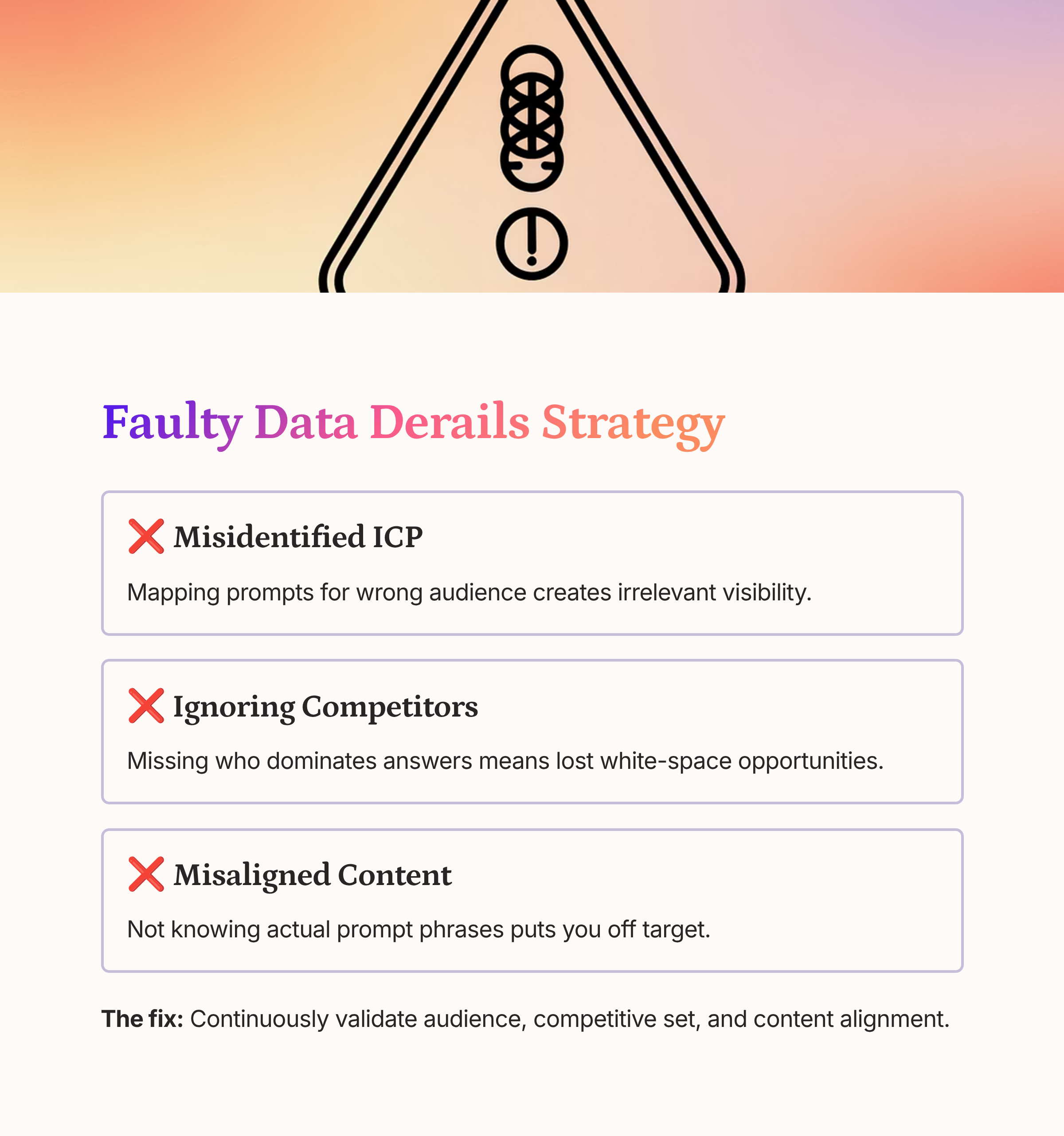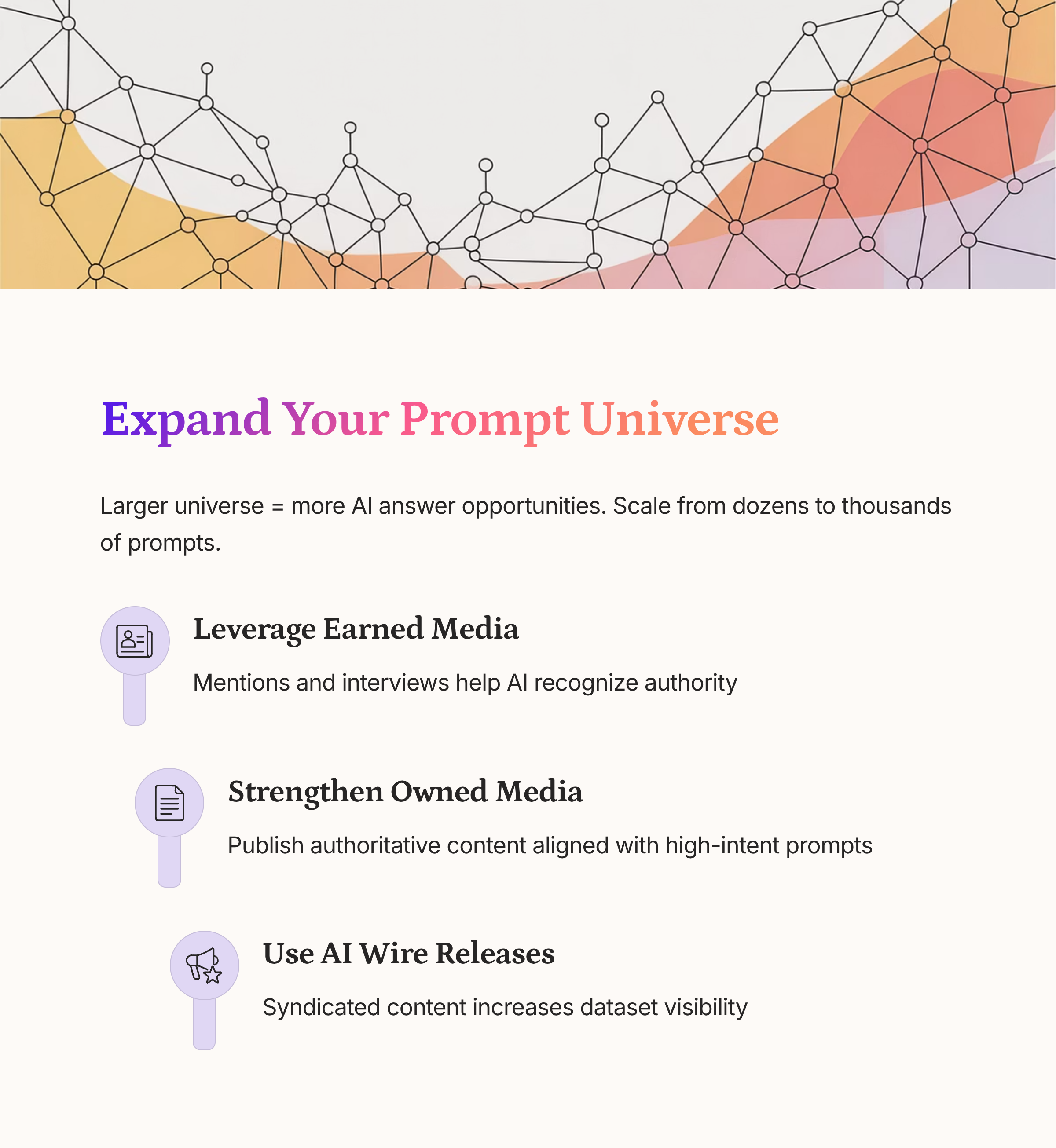TL;DR
A prompt index is a structured inventory of the questions (prompts) users feed into generative AI tools—along with data on how often a brand appears in those answers. For marketers, this is the new “visibility graph.” Unlike traditional SEO, prompt behavior is opaque; you can’t see search volume or ranking positions. Only a few players, Zen Media’s Prompt Discovery Index™, Semrush’s AI Visibility Toolkit, and Profound, currently offer insight into prompt-level visibility. Building a prompt index helps brands map buyer intent, fix faulty data, and expand their presence in the generative search landscape.
What Is a Prompt Index and Why It Matters
Generative AI has changed how people find answers. Instead of typing keywords into Google, they ask conversational tools like ChatGPT, Claude, Gemini, or Perplexity:
“What’s the best CRM for manufacturing companies in Europe?” n “Which cybersecurity platforms do Fortune 500s trust most?”
Each of these is a prompt, a natural-language query that triggers AI-generated content. A prompt index is the catalogue of prompts that matter for your brand or category, mapped across buyer stages and measured for visibility.
Zen Media describes it as “the next generation of search intelligence,” tracking the prompts that drive generative mentions across AI tools. Their Prompt Discovery Index™ builds a “Core 1,000 Prompt Universe™” that scales up to 10,000 prompts to measure where brands appear in AI-driven answers.
For marketers, it’s a critical shift. Visibility no longer stops at page-one rankings; it now lives in the answers people get from AI. As Ahrefs notes, “you can’t track AI like you can track traditional search,” because prompt data isn’t public or static.

Showing Up in AI Answers = Millions in Opportunity
When an AI model cites, paraphrases, or recommends a brand, that brand enters the decision loop—often before the user ever clicks a link.
Appearing in AI answers drives three competitive advantages:
- Authority signaling: The model treats your brand as a trusted source.
- Early-funnel capture: You influence research-stage questions that shape buyer decisions.
- Conversion-cycle acceleration: Buy-intent prompts directly recommend or shortlist solutions.
SEOClarity calls this the “visibility war” in AI search, where brands fight for inclusion in generated answers, not just rankings.
Brands that proactively map and grow their prompt universe unlock thousands of new discovery points—each a micro-moment of potential influence.
The Transparency Problem: You Can’t See Prompts (Yet)
Traditional search tools provide keyword volume, ranking data, and click-through rates. Generative AI offers none of that. The prompts users feed into ChatGPT or Gemini are private, model-driven, and constantly evolving.
“You can’t treat AI prompts like keywords… prompt volume data is locked away,” notes Ahrefs.
That’s why the emergence of visibility tracking tools matters. Semrush’s AI Visibility Toolkit aggregates brand share across generative engines instead of keyword rankings. Profound, a generative engine optimization (GEO) platform, focuses on tracking how brands appear across LLM-powered environments.
In short: the prompt index fills the gap between invisible AI prompts and measurable brand visibility.
Types of Prompts and What They Signal
Prompts reveal where a potential customer is in their journey. Marketers can classify them by intent:
| Prompt Type | Example | Buyer Intent Signal |
|—-|—-|—-|
| Informational | “What is predictive maintenance?” | Awareness / education |
| Navigational | “Is IBM Maximo the best predictive maintenance tool?” | Consideration |
| Transactional / Buy-Intent | “Top predictive maintenance platforms for mid-market OEMs” | Purchase readiness |
Mapping these categories helps brands align prompt visibility with funnel strategy: awareness prompts for thought leadership, navigational prompts for brand authority, and buy-intent prompts for conversion.
How Faulty Data Can Derail Your Prompt Strategy
Even the best prompt mapping fails if built on poor foundations. Common pitfalls include:
- Misidentified ICP or super-consumer – Mapping prompts for the wrong audience leads to irrelevant visibility.
- Ignoring key competitors – Without understanding who dominates prompt answers, brands miss white-space opportunities. Not just who you think your competitors are, but who is showing up in the answers.
- Misaligned content pillars – If you don’t know the keywords and phrases people are actually using in prompts (regardless of how they phrase the question or task), you’ll be off the mark.

Each data error compounds over time, warping your prompt index and your generative visibility strategy. The fix: continuously validate your audience, competitive set, and content alignment.
Building and Expanding a Prompt Universe

A larger prompt universe means more chances to appear in AI answers. Think of it as expanding from a few dozen prompts to thousands,each representing a question your brand could answer.
To grow your prompt universe:
- Leverage earned media — Mentions, interviews, and third-party articles help AI models recognize authority.
- Strengthen owned media — Publish authoritative, well-structured content aligned with high-intent prompts.
- Use generative AI wire press releases — Syndicated content on credible news wires increases dataset visibility.
These signals: earned, owned, and trustworthy press sources feed the ecosystems that large-language models draw from. The broader and more credible your footprint, the more likely your brand appears in AI-generated answers.
Key Players Powering Prompt Visibility
While the market is still early, three major players stand out:
- Zen Media – Prompt Discovery Index™: Tracks brand presence across prompts, buyer intents, and competitors using a proprietary Core 1,000 Prompt Universe™.
- Semrush – AI Visibility Toolkit: Provides visibility share analytics across generative engines and competitors.
- Profound: Focuses on “generative engine optimization” (GEO), helping brands monitor AI-driven visibility.
Together, they represent the emerging foundation for prompt intelligence, the AI-era equivalent of keyword analytics.
FAQ
**Q1. What exactly is a “prompt index”?
A structured list of generative-AI prompts tied to your brand’s audience and product category, tracked for visibility and frequency.
**Q2. Why can’t I just use keywords?
Because AI models don’t show rankings or volume data. Prompts are conversational, private, and dynamic.
**Q3. What’s “prompt share”?
It’s the percentage of prompts (in your mapped universe) where your brand appears in answers.
**Q4. How do I build one?
Define your ICP, buyer journey stages, and competitors. Then brainstorm and cluster prompts by intent, using tools like Zen Media’s PDI™ or Semrush’s toolkit to measure visibility.
**Q5. How can I expand my prompt universe?
Earn media coverage, publish authoritative content, and syndicate trusted press releases to increase AI citation potential.